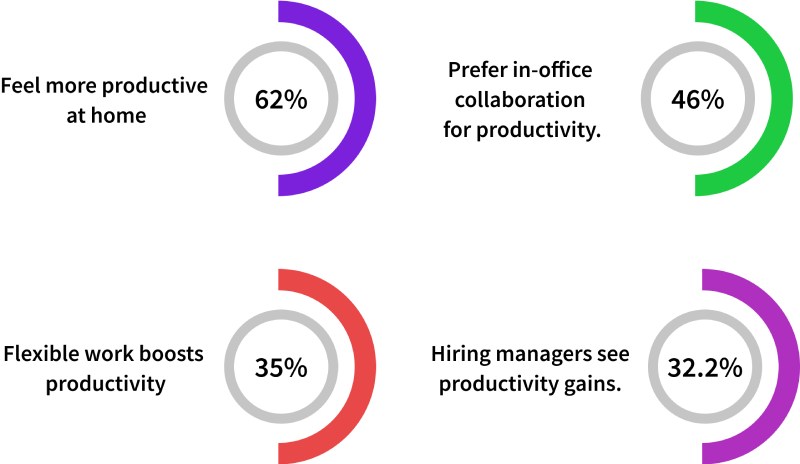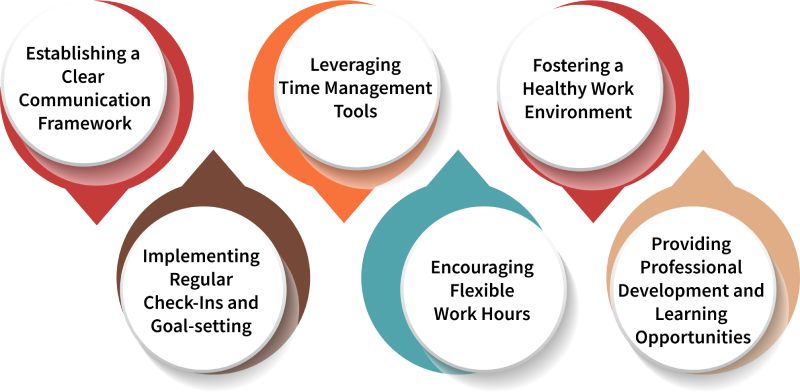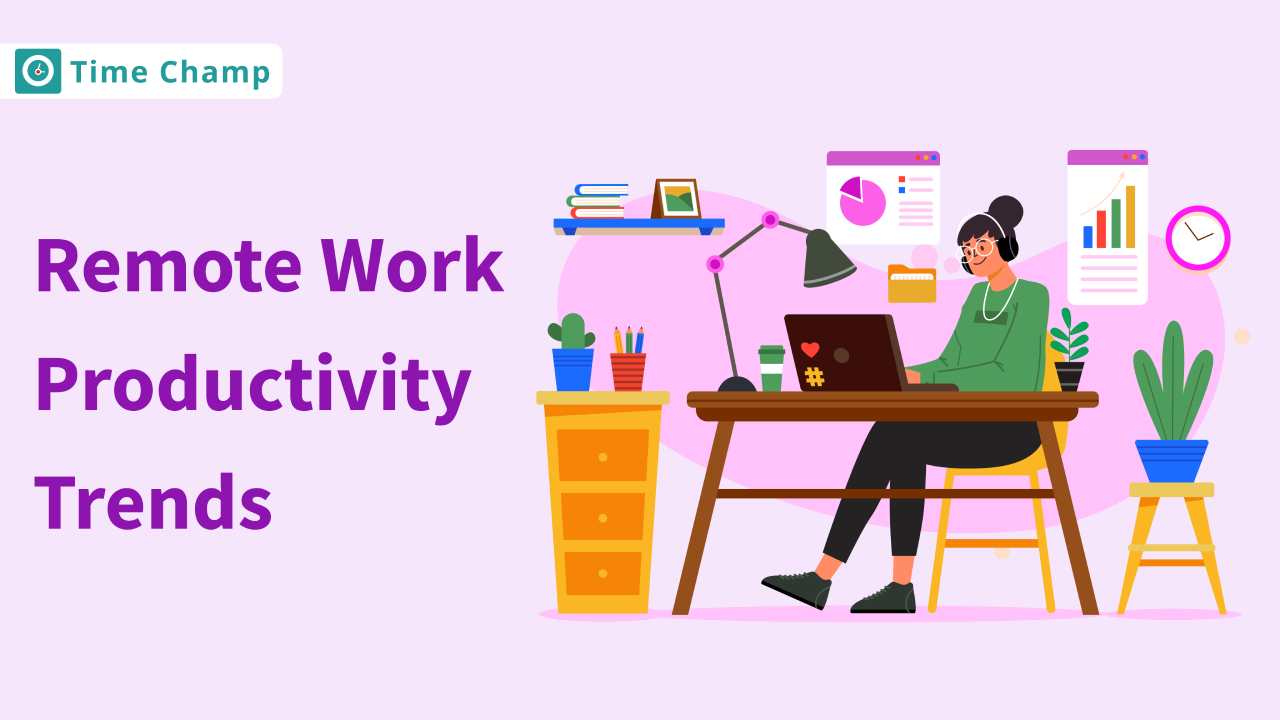The rise of remote work has sparked new discussions about productivity. These remote work productivity statistics offer a data-driven look into how remote teams are performing, where they excel, and what areas need improvement. Check out 40 crucial stats that reveal the true impact of remote work on productivity.
Key Statistics on Remote Work
Remote work is transforming the workplace. These key remote work statistics highlight the data you need to understand how this shift influences industry productivity and efficiency.
-
58% of the U.S. workforce now works remotely at least part-time.
-
72% of employers have reported that remote work has positively impacted employee retention rates.
-
85% of remote employees claim they are more productive working from home than in the office.
-
97% of remote workers would recommend remote work to others for its flexibility and work-life balance.
-
90% of employees consider remote work opportunities a critical factor in their decisions.
-
70% of tech companies have at least half of their workforce working remotely.
Remote Work Growth & Adoption Statistics
The last couple of years have seen dramatic growth in remote work, primarily driven by technological advancements and a general shift in workforce expectations. Here are some key statistics on remote work trends:

-
The percentage of employees working remotely worldwide rose from 20% in 2020 to 28% by 2023. In the U.S., around 22.8% of employees worked remotely at least part-time as of August 2024, translating to about 35.1 million people.
-
The global remote workplace market is predicted to expand at a compound annual growth rate of approximately 23.1%, reaching about $153.6 billion by 2032, from about $30.2 billion in 2023.
-
Industries like technology and finance have seen the greatest adoption. Nearly 70 percent of firms engaged in technology have shifted to remote work policies, while only 30 percent of manufacturing firms are among the likely adopters.
-
Most countries, like Canada and Australia, have also experienced strong participation of more than 50% of their employees in remote work during times of peak pandemic.
Employee Engagement & Remote Work Well-being
Employee Engagement are integral parts of any remote work setup. This section will describe how telecommuting affects these issues while underlining the need to establish a supportive environment for remote teams.
-
Gallup stated that 33% of remote workers reported being engaged at work compared with 30% of on-site employees. Thus, we realize that remote work can support engagement, however, it does vary by organization and by a group of employees.
-
According to Buffer’s 2021 State of Remote Work Report, 20% reported that communication is the biggest struggle with remote work. Organizations that operate using clear and consistent methods of communication are generally seen to have higher levels of Employee engagement and well-being engagement.
-
According to research conducted by Owl Labs, companies that allow employees to work remotely have 25% lower employee turnover rates than those that do not. Therefore, the presence of workers who can work from remote locations means that retention rates are higher, and reducing hiring costs preserves institutional knowledge.
-
Employees who are given the ability to work remotely are 13% likely to stay at their jobs for the next five years. This is a direct outcome of improved well-being and engagement because workers, in general, feel much more valued and supported by the organization when offered remote or hybrid work options.
Statistics on Remote Work Productivity
How productive are remote teams? This section features important statistics on remote work productivity, providing a clear overview of trends, challenges, and outcomes that shape the modern work experience.

Productivity Increase During Remote Work
A study by Prodoscore found that remote work productivity increased by 5% when comparing May-August 2019 to the same period in 2020. This data contradicts the common assumption that remote work leads to reduced productivity.
Remote Workers Outperform Their Office Peers
Based on a study, remote workers, generally, tend to be 35-40 percent more productive than their office-based counterparts. The statistics suggest that even the likes of Dell and American Express experience improvements in productivity that they attribute to flexible work models.
Two in Three Workers Feel More Productive Remotely
According to Owl Labs’ 2022 State of Remote Work Report, 62% of employees reported feeling more productive while working from home. In contrast, only 11% indicated a decrease in productivity, mainly citing distractions as the reason. Interestingly, this statistic varies by age, with 66% of millennials feeling most productive at home compared to only 46% of Baby Boomers. However, it’s worth noting that 53% of remote employees also reported working longer hours than they did in the office.
Hiring Managers See Productivity Increases
According to Upwork’s The Future of Work Report, 32.2% of hiring managers noted that productivity has improved since the adoption of remote work. However, 22.5% reported a decline in productivity, indicating mixed experiences among organizations.
Preference for In-Office Collaboration
While many remote workers enjoy the flexibility of having such arrangements, 46% still believe they are more productive during in-office collaboration. On the other hand, 22% hold that remote collaboration is more effective, and 33% opt for co-working spaces.
Work-Life Balance and Employee Satisfaction
The employees find work-life balance to be a critical component that makes employee satisfaction go high. Here are work-from-home statistics that demonstrate how flexible working enhances employee well-being and engagement:
Improves Work-Life Balance for Remote Workers
The survey conducted by FlexJobs found that 73% of the remote workers reported that they can strike a better work-life balance than when they were working in an office. It is mainly because of the benefits of reduced commute time, flexible working hours, and effective management of personal commitments. Besides, 77% of the survey respondents added that doing remote work helped make them healthier, both physically and mentally.
Employee Satisfaction is Higher in Remote Setups
Remote workers are 22% more likely to report satisfaction on the job, as compared to those working on the premises. It is primarily due to reasons such as autonomy, less distraction at work, and being more comfortable. 86% of employees want to continue working remotely even on a part-time basis because they do so at higher satisfaction levels.
Flexible Work Arrangements Boost Employee Loyalty
As per data reported in the 2022 Global Workforce Report by Willis Towers Watson, 82% of employees who work with flexible setup arrangements such as remote and hybrid models asserted that they feel more loyal to their employer. This means that organizations allowing employees to choose flexibility are likely to retain talent in the long term.
Fewer Sick Days and Absenteeism
Studies by Global Workplace Analytics found that remote workers take sick days 50% fewer times than in-office workers. Such differences could be partly due to the freedom to manage health needs at home and a much more relaxed work environment.
Mental Health and Well-Being
According to a survey by the American Psychological Association, 74% of remote workers reported having more time to engage in activities that support their mental health, such as exercise, hobbies, and family time. This contributes to greater overall satisfaction and improved well-being.
Best Practices for Improving Remote Work Productivity
Success in the flexible work environment today highly relies on enhancing remote work productivity. The following section outlines best practices that can help teams enhance efficiency, collaboration, and overall performance while working remotely.

Establishing a Clear Communication Framework
Clear communication channels are the most powerful motivators for increasing productivity in remote work. According to a report, 97% of remote workers reported that communication and collaboration tools are the key to their productivity. Slack, Microsoft Teams, and Zoom are some tools that allow employees to stay in touch with each other and limit miscommunication that delays work.
In addition, McKinsey & Company revealed that teams with effective communication show a 20-25% rise in productivity compared to those without effective communication protocols.
Implementing Regular Check-Ins and Goal setting
The check-ins with the manager if conducted regularly by the remote employees who are working from home, are reportedly 29% more productive and engaged. The frequent check-ins open up avenues for feedback, let priorities align, and keep the employees on track by meeting their aims. Also, the companies that set goals with remote teams experience an increase of 15% in the productivity of the employees.
Leveraging Time Management Tools
The use of time management tools has been proven to increase productivity by 30% among remote workers. Employees who track time and manage tasks better have fewer chances of procrastination and getting distracted, which allows them to produce higher output. Furthermore, 45% of the remote workers who used the tools said that they had an improvement in their ability of work-life balance ability.
Encouraging Flexible Work Hours
According to Owl Labs, a survey reported that 79% of remote employees who can work at flexible schedules have a higher output level than those confined to 9-5 rigidly scheduled work shifts. Allowing employees to choose the most productive hours will guarantee better concentration and less distraction for them, leading to increased output.
Fostering a Healthy Work Environment
According to a report, those companies that consider employee welfare by having better ergonomic arrangements, regular breaks, and mental health support increase employee productivity by 25%. The remote employee has been provided with a specific working space and a healthy environment helps to reduce fatigue and burnout which further allows them to work very efficiently.
Providing Professional Development and Learning Opportunities
LinkedIn’s 2022 Workplace Learning Report found that 58% of remote workers who have access to professional development and training resources feel more engaged and productive. Offering online courses, webinars, and skill-building workshops helps employees stay up to date-with industry trends and motivated to deliver high-quality work.
Demographic Insights: Who Benefits Most from Remote Work?
Leverage the advantages of remote work by identifying which demographics benefit the most. This section dives into key takeaways to identify groups that gain the most and how an organization can work to meet their needs.
Millennials and Gen Z Show Higher Preference for Remote Work
A Gallup study reveals that 74% of the Millennials and Gen Z generations prefer either full or hybrid remote work, while only 62% of the Gen X and Boomers. Younger generations comment on flexibility, good work-life balance, and travel-work-location opportunities as benefits of a remote setup. The ability to design flexible work arrangements is critical to attracting and retaining the younger talent.
Women Report Higher Job Satisfaction in Remote Setups
A survey found that 80% of women report better job satisfaction and work-life balance when working remotely compared to 70% of men. Women often benefit from the ability to manage family responsibilities alongside their professional roles, making remote work a valuable option for retaining female talent in the workforce.
Parents Are More Productive Working Remotely
Pew Research Center has found that 65% of parents with children below the age of 18 believe that remote work arrangements help balance their family commitments without any loss of productivity. Parents can better balance work and childcare as there are fewer pressures of commuting and flexible hours.
Senior Workers Prefer Hybrid Models Over Full-Time Remote
Older workers, such as the Boomers and Gen X, perform well under a hybrid work arrangement instead of a fully remote setup. The report revealed that 52% of aged staff liked working in a hybrid set-up since they may socially and naturally be connected with colleagues as well at work but have some flexibility. The hybrid work options prevent isolation and anxiety among older workers regarding fully remote roles.
Remote Work Has Reduced Attrition Rates for Minority Employees
Research from Fortune found that 35% of minority employees experienced higher retention rates and less workplace discrimination with remote work. The study suggests that the remote environment can lead to a more inclusive and equitable work culture.
Rural Workers See the Greatest Benefits in Remote Work
Remote work bridges the gap, which often takes place between rural or sparsely populated areas. According to a report by the Economic Innovation Group, 61% of rural workers responded that remote work has given them more job opportunities than were previously unreachable. At the same time, remote working minimizes long commutes, which is advantageous for the residents in rural regions.
The Future of Remote and Hybrid Work Models
When it comes to future of remote work “Remote work is here to stay. It’s not just a trend; it’s a fundamental change in how we work and live.” — Matt Mullenweg.
This insight given by the WordPress co-founder captures the nature of the transformation into working remotely or in hybrid. To get further into the future of this trend, we need to know how these new arrangements are going to redefine our workplaces and influence our lives.
-
By 2028, as much as 73% of employees in all departments across every industry will be working remotely. This means remote work becomes an evergreen characteristic of the professional landscape and changes the profile of how businesses operate.
-
Companies can save up to 50% of costs on office space using hybrid work models and approximately $11,000 per year for every employee who works a two-to-three-day hybrid schedule. That’s a great cost advantage for organizations aiming to cut down on overhead expenses.
-
98% of employees prefer working remotely, either full-time or part-time. That fact alone speaks volumes about its popularity and appeal. More employees wish to work remotely for benefits associated with having a better work-life balance, less stress when trying to commute, or more freedom over their work arrangements.
-
95% of business leaders state that their organizations have become more agile over the past two years, and 82% report that they will continue to enhance agility over the next two years. Such a commitment underscores a strong desire to evolve and adapt workplace models to meet the changing demands and needs of employees while improving productivity.
-
The HR sector is more likely than others to prefer the hybrid work model, followed by legal and IT. Approximately 32% of professionals in the legal industry work a hybrid schedule, while 11% work fully remote. On the other hand, industries such as food services, transportation, and manufacturing have the lowest remote and hybrid work adoption rates due to the need for physical interaction and on-site presence to perform job tasks effectively.
Conclusion
In conclusion, the shifts in remote work continue to shape the productivity trend. These 40 statistics provide a view of how the structure of remote work transformed employee efficiency, collaboration, and overall business outcomes. Hence, while companies are charting their way forward to the future of work, it will be extremely helpful to understand these trends while making an informed decision towards maintaining both productivity and employee well-being. Remote work is here to stay, and the trend is set to outlive many. Therefore, continued information on its implications would be very key for long-term success.
Boost your remote team productivity with Time Champ!
Explore our features designed to enhance engagement and streamline your workflow.
Signup for FreeBook DemoFrequently Asked Questions
The best tools that help manage remote work productivity include time and productivity tracking software such as Time Champ, project management platforms such as Asana or Trello, communication tools like Slack, and collaboration software such as Google Workspace. All these helps track time, organize tasks, and enhance team collaboration.
The workspace design becomes crucial in performing remote work productively, where it eliminates distractions and brings comfort to the individual. Proper lighting, ergonomic furniture, as well as minimal clutter, characterize a dedicated, organized space that promotes focus because it will encourage a structured workday as well as boundaries between work and life at home.
The most common pitfalls of remote work include distraction from home life, lack of routines, too much work because of unclear boundaries, isolation due to a lack of social interaction, and communication breakdowns. All these issues may lead to poor concentration, burnout, and lack of collaboration with remote teams.
Productivity can be measured at a remote location by keeping track of the time spent on all tasks, setting clear goals, and evaluating the output. Many tools, such as time-tracking apps, help with this, along with regular review of your process to ensure you are meeting your given deadlines and maintaining the same levels of consistent performance.






